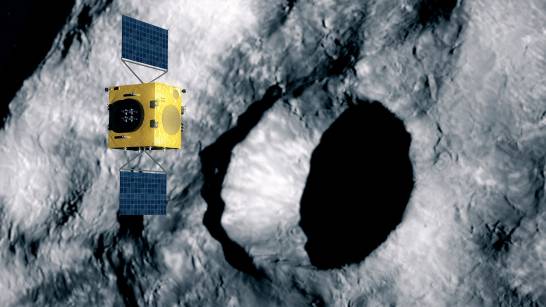The ESA Hera mission team congratulated their counterparts on NASA’s DART mission for their historic impact with the asteroid Dimorphos. At a speed of more than 6 km per second, the American ship, the size of a refrigerator, collided with this 160 m diameter object at dawn on Tuesday (in Europe, Monday in America). This is the first time that humanity has tested this method of planetary defense called ‘kinetic impactor‘.
Ian Carnelli, mission director Hera, said: “Making contact with such a small target at 11 million kilometers is an impressive technical achievement in its own right, a wonderful page of space history has been written tonight. A page we’ve all been waiting for many years. Today our thoughts are also with the late Professor Andrea Milani, who was the first to outline this deviation test in 2004″.
Now begins a period of observation by ground-based and space-based telescopes to determine whether the DART impact really achieved what was intended, and to move the orbit of the small ‘moon’ Dimorphos around its parent asteroid Didymos, which is about 780 m in diameter.
“In parallel, ESA and our industrial partners continue to work on the construction of the Hera spacecraft. [denominada como la diosa griega del matrimonio], which will launch in late 2024, starting its own journey to Dimorphos to closely study the asteroid after impact. Hera will gather important information such as the size of the crater that DART produced, the mass of Dimorphos, as well as their composition and internal structure. This data will help transform the DART deflection experiment into a well-understood and repeatable technique that could one day be performed in real life.”
International team with NASA and ESA
NASA’s DART and ESA’s Hera missions are supported by scientists from several countries through an international collaboration called AIDA (Asteroid Impact and Deflection Assessment), an example that planetary defense knows no borders.
In fact, the two missions were conceived together during the first years of the 21st century, when concerns about the destructive potential of asteroids arriving at Earth led to the creation of the first automated tracking systems, which gave rise to the Near-Earth Object of the ESA Center. Coordination Unit (NEO-CC), and to the system Sentinel from NASA.
But soon the space scientists working on these systems realized that it wasn’t enough to identify the asteroid threat, they also needed to find a way to deal with it.
Ian recalls: “Mathematician and astronomer Andrea Milani of the University of Pisa – a pioneer of planetary defense who unfortunately passed away in 2018 – came up with the idea for a two-space mission that he called Don Quixote: one spacecraft would hit an asteroid and the other would observe and measure the degree of deflection.”
The concept became international and NASA took over what would become DART. For its part, ESA’s Hera spacecraft will follow its predecessor into space in 2024 and arrive at Dimorphos two years later. Its target asteroid will be of particular importance as it is the first body in the solar system whose surface and orbit have been measurably modified by human intervention. Its name comes from the Greek and means “with two forms”.
The ship Hera is taking shape
Hera’s payload module is taking shape at OHB’s facility in Germany, while its propulsion module is being finalized at Avio’s in Italy. Other companies and institutions from 17 European countries also contribute to the mission, such as Spain’s GMV, which is developing the automated guidance, navigation and control system that will allow the spacecraft to safely navigate this dual asteroid system, in a similar way to an autonomous car.
Hera mission propulsion module at Avio company premises in Italy in September 2022. / Avio
The table-sized Hera spacecraft is filled with instruments, such as asteroid framing camera supported by thermal and spectral detectors, or your laser altimeter to map the asteroid’s surface.
Alongside Hera will travel two small satellites: a pair of shoebox-sized CubeSats, which will also move in the Dimorphos environment. The Juventas satellite will carry out the first radar survey of an asteroid, while carrying a gravimeter and an accelerometer to measure the very low gravity of the object.
The other CubeSat, Milani – named after the ideologist and inventor of AIDA – will take near-infrared spectral images and samples of the asteroid’s dust.
Illustration of the Hera spacecraft with its two small complementary satellites (Juventas and Milani). In the background the dual asteroid system Dimorphos (the main objective, where NASA’s DART spacecraft impacted) and Didymos. / THIS
The two CubeSats will be in contact with each other and with their Hera mothership via a new satellite link system, to gain experience monitoring multiple spacecraft in exotic near-weightless conditions, before finally landing. in Dimorphos.
Ian concludes: “Thanks to DART, we took a look at our destiny. Now we can’t wait to go back and explore it further, to find out how the impact changed it and, in the process, help make Earth a safer place.”
